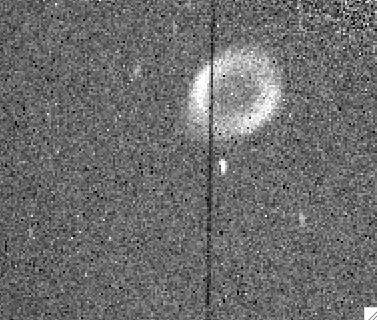FAQ: CCDSoft insists on taking subframe
2008 Dec 16: It's easy to tell CCDSoft to take a
subframe by mistake: If you click and drag inside
an existing CCD frame, it will define that as a
subframe, and then only download that subframe
from the CCD. You can fix this by going into the
'Take Image' tab, and unticking the 'Subframe'
tickbox. The full CCD frame will then be
downloaded.
Spectrum of the Ring Nebula
2008 July 20: Finally checked out the
focus on the spectrograph. The focus used for
the labs was about 3700; at this setting, the
image is basically an image of the mirror. This
had the advantage that we could easily place the
image on the slit, and the disadvantage that
there weren't many photons getting through the
slit, more-or-less limiting us to 1st magnitude
stars. The focus was revised, first on Vega,
and then on Sulafat (gamma Lyrae), as Vega started
to saturate the detector. The final focus was
at 3250+/-10. This meant going inwards, which is
the bad direction. If switching from imaging with
the CCD + filter wheel to spectroscopy with the
SGS, I'd recommend going in by about 600 or 700,
all in one go, and then coming out by steps of 20.
 As long as I had a reasonable focus on the
telescope + spectrograph, I picked up a spectrum
of the Ring Nebula, just nearby. With the LX200
sync'd to Sulafat, the Ring Nebula came straight
into the guider, with the slit across it. Neat.
This image has a 60s on-source integration time.
As long as I had a reasonable focus on the
telescope + spectrograph, I picked up a spectrum
of the Ring Nebula, just nearby. With the LX200
sync'd to Sulafat, the Ring Nebula came straight
into the guider, with the slit across it. Neat.
This image has a 60s on-source integration time.
A section of the CCD image (below), showing
the raw spectrum of the Ring Nebula: Integration
time 600s (on-source); red is to the left.

 As long as I had a reasonable focus on the
telescope + spectrograph, I picked up a spectrum
of the Ring Nebula, just nearby. With the LX200
sync'd to Sulafat, the Ring Nebula came straight
into the guider, with the slit across it. Neat.
This image has a 60s on-source integration time.
As long as I had a reasonable focus on the
telescope + spectrograph, I picked up a spectrum
of the Ring Nebula, just nearby. With the LX200
sync'd to Sulafat, the Ring Nebula came straight
into the guider, with the slit across it. Neat.
This image has a 60s on-source integration time.
